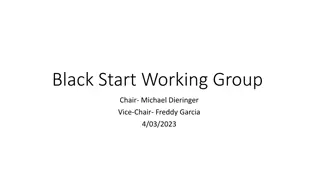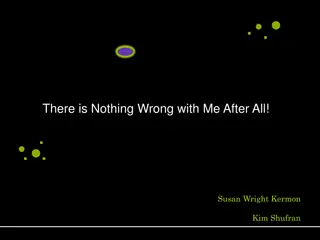Structural Analysis: The Woman in Black by Susan Hill
In this structural analysis, key subject terminology and structural features are explored to understand how writers use these elements to achieve effects and influence readers. The focus is on a specific extract from The Woman in Black by Susan Hill, analyzing how the author utilizes structural features to create suspense and engage the audience.
Download Presentation

Please find below an Image/Link to download the presentation.
The content on the website is provided AS IS for your information and personal use only. It may not be sold, licensed, or shared on other websites without obtaining consent from the author.If you encounter any issues during the download, it is possible that the publisher has removed the file from their server.
You are allowed to download the files provided on this website for personal or commercial use, subject to the condition that they are used lawfully. All files are the property of their respective owners.
The content on the website is provided AS IS for your information and personal use only. It may not be sold, licensed, or shared on other websites without obtaining consent from the author.
E N D
Presentation Transcript
Paper 1 Question 3 Structure Analysis AO2 Explain, comment on and analyse how writers use structural features to achieve effects and influence readers, using relevant subject terminology to support their views. Miss Di.Giampasquale
Subject Terminology Structural Features Subject Terminology Definition The point of view that the text is written from (1st person etc.) Beginning/Middle/End The use of speech in a text. Shift The basic plot of any piece of writing. Narrative Perspective The use of , . ; ! - to create pauses and change the pace/tone of a piece of writing. Flashback The writer has changes our focus from one thing to another. Dialogue Opposing ideas in a text/within a sentence. Cliff Hanger When lots of adjectives/phrases/objects/nouns are put in a list to create an effect. Punctuation for effect An event or scene taking place before the present time in the narrative is inserted into the chronological structure of the work. Juxtaposition / Paradox A text that follows the events in the order that they occurred. Foreshadowing Disjointed or disrupted narrative that does not follow the normal order. Listing A dramatic and exciting ending that leaves the audience in suspense. Linear Narrative An indication of a future event in the text / A hint of what we can expect later. Non-Linear Narrative The story is structured in a logical manner by telling what happens from one point in time to the next without using flashbacks or flash-forwards. Chronological
How to get the marks! Paragraph 2 Paragraph 3 Paragraph 1 1-2 Marks 3-5 Marks What happens in the text? 6-8 Marks - Beginning Comment on the effect that the opening/ending have on the reader. - Middle Comment on Structural Features and the effect they create: - End Is there a shift? Give a quotation for each of this plot points. - Flashback - Change in setting - Dialogue - Change in character - Cliff hanger - Change in tone - Punctuation for effect Key Phrases: The writer focuses our attention on The writer changes our focus to The text shifts from ____ to ____ - Juxtaposition / Paradox What different sentence lengths/types are being used? What effect do these have on the reader? - Foreshadowing - Listing What is the Narrative Perspective? What is the effect of this? Grade 9 Make a comment on the overall structure of the text and why you thing the writer has done this: - Linear Narrative Buzz Words: Shift Beginning Middle End Focus - Non-Linear Narrative - Chronological Miss Di.Giampasquale
It is not ok to just identify different structural features you must analyse what effect these have on the reader. You will need to analyse a minimum of 4 quotations to be able to hit this level. Ideally you want to include 4-6 quotations. You must use subject terminology, otherwise you cannot get above 2marks. Miss Di.Giampasquale
Now annotate this text using what you know about structure: SOURCE A This extract is from the middle of The Woman in Black, a novella by Susan Hill first published in 1983. In this section Arthur Kipps, a junior solicitor, is staying overnight in Eel Marsh House in order to sort through some legal papers. The house is supposed to be empty following the death of its elderly and reclusive former inhabitant Alice Drablow. The Woman in Black At first, all seemed very quiet, very still, and I wondered why I had awoken. Then, with a missed heart-beat, I realized that Spider was up and standing at the door. Every hair of her body was on end, her ears were pricked, her tail erect, the whole of her tense, as if ready to spring. And she was emitting a soft, low growl from deep in her throat. I sat up paralysed, frozen, in the bed, conscious only of the dog and of the prickling of my own skin and of what suddenly seemed a different kind of silence, ominous and dreadful. And then, from somewhere within the depths of the house but somewhere not very far from the room in which I was I heard a noise. It was a faint noise, and, strain my ears as I might, I could not make out exactly what it was. It was a sound like a regular yet intermittent bump or rumble. Nothing else happened. There were no footsteps, no creaking floorboards, the air was absolutely still, the wind did not moan through the casement. Only the muffled noise went on and the dog continued to stand, bristling at the door, now putting her nose to the gap at the bottom and snuffling along, now taking a pace backwards, head cocked and, like me, listening, listening. And, every so often, she growled again. In the end, I suppose because nothing else happened and because I did have the dog to take with me, I managed to get out of bed, though I was shaken and my heart beat uncomfortably fast within me. But it took some time for me to find sufficient reserves of courage to enable me to open the bedroom door and stand out in the dark corridor. The moment I did so, Spider shot ahead and I heard her padding about, sniffing intently at every closed door, still growling and grumbling down in her throat. After a while, I heard the odd sound again. It seemed to be coming from along the passage to my left, at the very far end. But it was still quite impossible to identify. Very cautiously, listening, hardly breathing, I ventured a few steps in that direction. Spider went ahead of me, the passage led only to three other bedrooms on either side and, one by one, regaining my nerve as I went, I opened them and looked inside each one. Nothing, only heavy old furniture and empty unmade beds and, in the rooms at the back of the house, moonlight. Down below me on the ground floor of the house, silence, a seething, blanketing, almost tangible silence, and a musty darkness, thick as felt. And then I reached the door at the very end of the passage. Spider was there before me and her body, as she sniffed beneath it, went rigid, her growling grew louder. I put my hand on her collar, stroked the rough, short hair, as much for my own reassurance as for hers. I could feel the tension in her limbs and body and it answered to my own. This was the door without a keyhole, which I had been unable to open on my first visit to Eel Marsh House. I had no idea what was beyond it. Except the sound. It was coming from within that room, not very loud but just to hand, on the other side of that single wooden partition. It was a sound of something bumping gently on the floor, in a rhythmic sort of way, a familiar sound and yet one I still could not exactly place, a sound that seemed to belong to my past, to waken old, half-forgotten memories and associations deep within me, a sound that, in any other place, would not have made me afraid but would, I thought, have been curiously comforting, friendly. But at my feet, the dog Spider began to whine, a thin, pitiful, frightened moan, and to back away from the door a little and press against my legs. My throat felt constricted and dry and I had begun to shiver. There was something in that room and I could not get to it, nor would I dare to, if I were able. I told myself it was a rat or a trapped bird, fallen down the chimney into the hearth and unable to get out again. But the sound was not that of some small, panic-stricken creature. Bump bump. Pause. Bump bump. Pause. Bump bump. Bump bump. Bump bump.
Sample Answer At the beginning the writer focuses our attention on the quiet and still(ness) of the scene. He then introduces a noise which immediately interests the reader as it is unclear what is making this sound. In the middle, the writer continues to hold the reader s intrigue by commenting on this odd sound again. The noise is becoming more frequent as Arthur Kipps explores the house. This makes the reader want to find out the source of the noise, just like the character does. In the last paragraph, at the end, the writer is focusing our attention on sound: whine moan the sound . This sparks the reader s interest as we are still unclear what has made the original noise . The writer constantly changes our focus from Arthur Kipps to the dog to the noise . He does this to show the effect the noise is having on the characters the dog is mirroring the fear of his owner. The writer juxtaposes the silence with this unknown sound by saying no footsteps, no creaking floorboards, the air was absolutely still . He does this to emphasise how unnerving this mysterious sound is, which we see in the parallelism of the prickling of Arthur s skin with the bristling of the dog s hair. The writer ends on a cliff-hanger by repeating the onomatopoeic word bump . By interspersing this with the word pause the reader is able to imagine the sound very vividly. It also replicates the sound of a heartbeat, and as the pauses disappear we can infer that the heart beat (just like the tension of the story) is quickening. This makes the reader begin to panic for the protagonist as things are beginning to come to a climax. The overall structure of the piece is a linear narrative. It is chronologically ordered, which is signposted by the discourse markers at the start of each paragraph at first in the end after a while and then . The use of these time connectives clearly show the order of what is happening. The writer does this to keep the pace and momentum moving forward, which builds tension and suspense for the reader. Miss Di.Giampasquale
The main character in this short story is a boy, though we dont get to know his name or age. At this mid-point in the story, he is playing amongst some rubble on the site of a demolished building. Everything seems normal to begin with, however One evening, the boy was crouched on top of the mound making a new town out of a heap of broken glass. He liked this time of day best after tea, before bed. The air seemed to get grainy as its colour changed from vinegary yellow to candyfloss blue. He could rub it between his fingers like dust and slow time down. At the top of the mound he was in charge and he didn t want to go home to bed. He collected green glass shards and broken brown bottle necks. He tumbled fragments of old window in his hands like shattered marbles. He pushed the glass into the mound, making houses, balancing roofs on them, building towers. The last of the sunlight caught and glinted in the tiny glass walls. More of the black birds than he d ever seen before rushed overhead and gathered on the lamppost. The orange light hadn t yet switched on but the shadows were growing. He heard nine chimes of the town hall clock. For a moment, the lamppost looked like a tall thin man wearing a large black hat. When the man turned towards him, he looked like a lamppost. The man had a greyish-green coat speckled with rust and a black hat that quivered with beaks and feathers. The man didn t need to climb the mound; he was face to face with the boy with his feet still planted in the pavement. What are you making? asked the man. The boy didn t answer. Every child is always making something. Shake them out and they re full of dust and dreams. The boy stood up, ready to run, but then he remembered that at the top of the mound he was king. He dug his heels into the rubble. I m making a new town, better than this one. The sun can shine in through the walls. The buildings look grander. It ll be a great glass city. All it needs is people, said the man. Yes, it needs people, said the boy. And when he looked down, tiny creatures were scuttling beneath the glass roofs. They looked like ants or spiders, but the sky was darkening and the creatures were moving too fast to be sure. He looked to the man but there was only the lamppost and as its orange light snapped on, the birds launched into the sky. The boy plunged down the mound and ran, hoping he wouldn t get told off for being late home. Before he reached the end of the street he knew something was wrong. The world was too quiet. Where were the sounds of cars? Of footballs being kicked against walls? There were no shouts from parents calling everyone in. Mum? He pushed open their front door. The house was in darkness but the telly was switched on. His mum wasn t in any of the rooms. A half-drunk cup of tea had been left on the arm of the settee. The boy thundered back along the silent streets. He stood in the orange light beneath the lamppost. Give them back, he shouted. Nothing happened, although he could hear the rustle of feathers coming from the darkness above the light. The boy ran to the top of the mound. Give them back! But I haven t got them, The man s face glowed. You have. In the gloom, it was hard to make out the tiny creatures beneath the glass roofs. They were no longer moving. The boy couldn t be sure what was a particle of rubble and what was a person sleeping in their broken-glass house. How do I get them back? he asked. But the man was a lamppost again.
Plan your answer: Paragraph 2 Paragraph 3 Paragraph 1 1-2 Marks 3-5 Marks - Beginning 6-8 Marks Comment on the effect that the opening/ending have on the reader. Comment on Structural Features and the effect they create: - Middle - Flashback Is there a shift? - Dialogue - Change in setting - Cliff hanger - Change in character - Punctuation for effect - Change in tone - Juxtaposition / Paradox - Foreshadowing - End - Listing What different sentence lengths/types are being used? What effect do these have on the reader? What is the Narrative Perspective? What is the effect of this? Overall Structure: Miss Di.Giampasquale





























